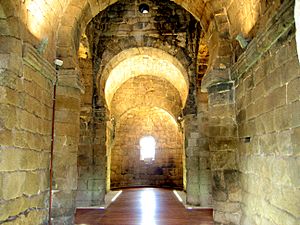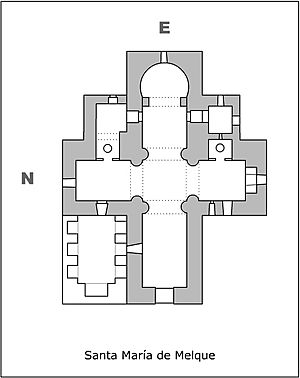Santa María de Melque facts for kids
Santa María de Melque is a very old church located near the town of San Martín de Montalbán in the province of Toledo, Spain. It's part of a larger group of buildings called the Monastic Complex of Melque. This church is special because it's one of the best examples of religious buildings from the early 700s in the Toledo area. It's also the largest early medieval church in Western Europe that still has its original vaulted (arched) ceilings.
After the Toledo Provincial Council bought the complex, experts dug up and fixed many parts of it. Now, there's a special center where you can learn all about its history.
Contents
History of Santa María de Melque
The area where Santa María de Melque stands was once a Roman settlement. There were even five dams built across the small streams around a rocky hill. The church itself started as a monastery, a place where monks lived and prayed, within the Catholic Kingdom of Toledo. Building began in the 600s, around the time the Visigothic kingdom was ending.
It's possible that the arrival of the Arabs in Spain might have paused the construction. However, the church's design also shows influences from Syria, especially from the Umayyad period. It seems that an Islamic community also lived here in the 700s.
Melque's Role After the Reconquest
When King Alfonso VI of León and Castile took over Toledo in 1085, the church became a place of worship again. But it also kept its role as a military outpost. You can still see signs of this, like old tombs shaped like people and parts of defensive walls.
In the 1800s, the church stopped being used for worship. This happened because many religious sites were taken over by the government during that time.
Architecture of the Church
The church was finished in the 700s. It's one of the best-preserved buildings from the High Middle Ages in Spain. The way it was built shows techniques from late Roman architecture.
At first, Santa María de Melque might have been a mausoleum, a grand tomb for an important person from Toledo's Visigothic Kingdom. This is suggested by the few decorations found, like stucco designs on the arches. The church was changed and redesigned at least two times over the years.
How the Knights Templar Changed Melque
The Knights Templar, a famous group of warrior monks, turned the church into a defensive tower. The Romans called such a tower a turris. This tower, which was built on top of the church's dome, has since been taken down. The church also used to have a porch with three openings, but that is gone now.
The church's layout is shaped like a cross, which is called cruciform. It has a main apse (a rounded end part) and two smaller ones that were added later. The different parts of the church, like its main halls (naves) and some side chapels, are still in good condition. It also has a special room with distinct horseshoe arches.
The area where the priests would stand, called the presbytery, was designed for a monastic community. It has round arches on both sides. A tower with a Moorish style is also preserved above the main arched ceiling.
Different Styles in Melque's Design
This church shows a mix of different building styles:
- Visigothic Style: You can see this in the horseshoe arch that supports the apse's ceiling. This arch is very curved, more than usual. Also, some carved stone pieces found here are in the Visigothic tradition. An arcosolium, which is an arched recess for a tomb, is also present.
- Mozarabic Style: This style, from Christians living under Muslim rule, appears in the central horseshoe arches. These arches are even more curved. The arches of the windows are also very curved. There are also unusual semi-circular pillars inside that look like they are partly attached to the wall.
- New Ideas: The church has unique circular corners on its four sides. There are also vertical cracks on both sides that look like fake columns. This design is similar to columns found on the corner towers of Romanesque Norman churches, which was a new idea at the time.
See also
 In Spanish: Iglesia de Santa María de Melque para niños
In Spanish: Iglesia de Santa María de Melque para niños



